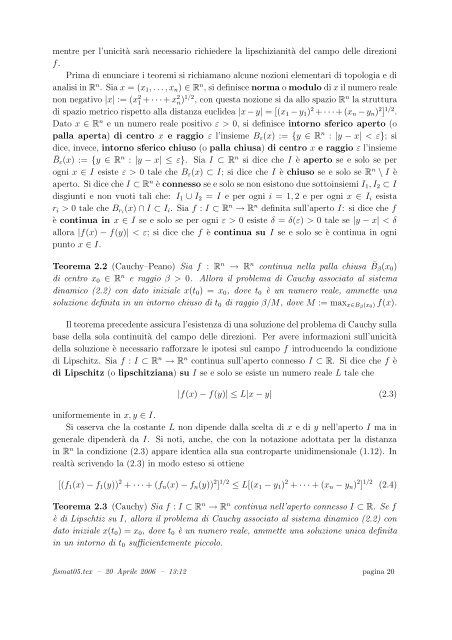Esercizi e appunti per il corso di Fisica Matematica - Sezione di ...
Esercizi e appunti per il corso di Fisica Matematica - Sezione di ...
Esercizi e appunti per il corso di Fisica Matematica - Sezione di ...
Create successful ePaper yourself
Turn your PDF publications into a flip-book with our unique Google optimized e-Paper software.
mentre <strong>per</strong> l’unicità sarà necessario richiedere la lipschizianità del campo delle <strong>di</strong>rezionif.Prima <strong>di</strong> enunciare i teoremi si richiamano alcune nozioni elementari <strong>di</strong> topologia e <strong>di</strong>analisi in R n . Sia x = (x 1 , . . . , x n ) ∈ R n , si definisce norma o modulo <strong>di</strong> x <strong>il</strong> numero realenon negativo |x| := (x 2 1 + · · · + x2 n )1/2 , con questa nozione si da allo spazio R n la struttura<strong>di</strong> spazio metrico rispetto alla <strong>di</strong>stanza euclidea |x − y| = [(x 1 − y 1 ) 2 + · · · + (x n − y n ) 2 ] 1/2 .Dato x ∈ R n e un numero reale positivo ε > 0, si definisce intorno sferico a<strong>per</strong>to (opalla a<strong>per</strong>ta) <strong>di</strong> centro x e raggio ε l’insieme B ε (x) := {y ∈ R n : |y − x| < ε}; si<strong>di</strong>ce, invece, intorno sferico chiuso (o palla chiusa) <strong>di</strong> centro x e raggio ε l’insieme¯B ε (x) := {y ∈ R n : |y − x| ≤ ε}. Sia I ⊂ R n si <strong>di</strong>ce che I è a<strong>per</strong>to se e solo se <strong>per</strong>ogni x ∈ I esiste ε > 0 tale che B ε (x) ⊂ I; si <strong>di</strong>ce che I è chiuso se e solo se R n \ I èa<strong>per</strong>to. Si <strong>di</strong>ce che I ⊂ R n è connesso se e solo se non esistono due sottoinsiemi I 1 , I 2 ⊂ I<strong>di</strong>sgiunti e non vuoti tali che: I 1 ∪ I 2 = I e <strong>per</strong> ogni i = 1, 2 e <strong>per</strong> ogni x ∈ I i esistar i > 0 tale che B ri (x) ∩ I ⊂ I i . Sia f : I ⊂ R n → R n definita sull’a<strong>per</strong>to I: si <strong>di</strong>ce che fè continua in x ∈ I se e solo se <strong>per</strong> ogni ε > 0 esiste δ = δ(ε) > 0 tale se |y − x| < δallora |f(x) − f(y)| < ε; si <strong>di</strong>ce che f è continua su I se e solo se è continua in ognipunto x ∈ I.Teorema 2.2 (Cauchy–Peano) Sia f : R n → R n continua nella palla chiusa ¯B β (x 0 )<strong>di</strong> centro x 0 ∈ R n e raggio β > 0. Allora <strong>il</strong> problema <strong>di</strong> Cauchy associato al sistema<strong>di</strong>namico (2.2) con dato iniziale x(t 0 ) = x 0 , dove t 0 è un numero reale, ammette unasoluzione definita in un intorno chiuso <strong>di</strong> t 0 <strong>di</strong> raggio β/M, dove M := max x∈Bβ (x 0 ) f(x).Il teorema precedente assicura l’esistenza <strong>di</strong> una soluzione del problema <strong>di</strong> Cauchy sullabase della sola continuità del campo delle <strong>di</strong>rezioni. Per avere informazioni sull’unicitàdella soluzione è necessario rafforzare le ipotesi sul campo f introducendo la con<strong>di</strong>zione<strong>di</strong> Lipschitz. Sia f : I ⊂ R n → R n continua sull’a<strong>per</strong>to connesso I ⊂ R. Si <strong>di</strong>ce che f è<strong>di</strong> Lipschitz (o lipschitziana) su I se e solo se esiste un numero reale L tale che|f(x) − f(y)| ≤ L|x − y| (2.3)uniformemente in x, y ∈ I.Si osserva che la costante L non <strong>di</strong>pende dalla scelta <strong>di</strong> x e <strong>di</strong> y nell’a<strong>per</strong>to I ma ingenerale <strong>di</strong>penderà da I. Si noti, anche, che con la notazione adottata <strong>per</strong> la <strong>di</strong>stanzain R n la con<strong>di</strong>zione (2.3) appare identica alla sua controparte uni<strong>di</strong>mensionale (1.12). Inrealtà scrivendo la (2.3) in modo esteso si ottiene[(f 1 (x) − f 1 (y)) 2 + · · · + (f n (x) − f n (y)) 2 ] 1/2 ≤ L[(x 1 − y 1 ) 2 + · · · + (x n − y n ) 2 ] 1/2 (2.4)Teorema 2.3 (Cauchy) Sia f : I ⊂ R n → R n continua nell’a<strong>per</strong>to connesso I ⊂ R. Se fè <strong>di</strong> Lipschtiz su I, allora <strong>il</strong> problema <strong>di</strong> Cauchy associato al sistema <strong>di</strong>namico (2.2) condato iniziale x(t 0 ) = x 0 , dove t 0 è un numero reale, ammette una soluzione unica definitain un intorno <strong>di</strong> t 0 sufficientemente piccolo.fismat05.tex – 20 Apr<strong>il</strong>e 2006 – 13:12 pagina 20
















